check engine light CHEVROLET EXPRESS 1998 1.G User Guide
[x] Cancel search | Manufacturer: CHEVROLET, Model Year: 1998, Model line: EXPRESS, Model: CHEVROLET EXPRESS 1998 1.GPages: 386, PDF Size: 20.74 MB
Page 133 of 386
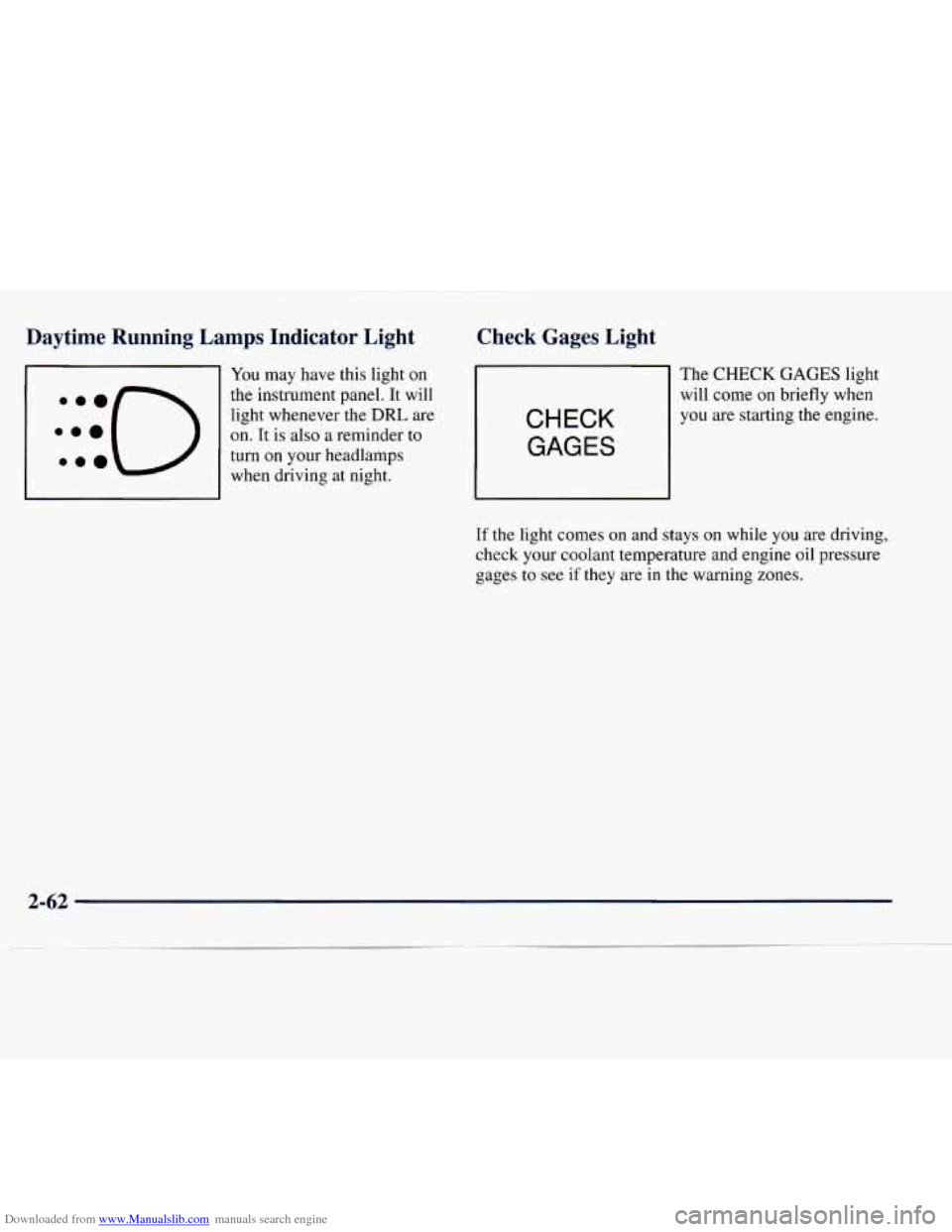
Downloaded from www.Manualslib.com manuals search engine Daytime Running Lamps Indicator Light
You may have this light on
the instrument panel. It will
light whenever the
DRL are
on. It is also a reminder to
turn on your headlamps
when driving at night.
Check Gages Light
CHECK
GAGES
The CHECK GAGES light
will come on briefly when
you are starting the engine.
If
the light comes on and stays on while you are driving,
check your coolant temperature and engine oil pressure
gages
to see if they are in the warning zones.
2-62
Page 170 of 386
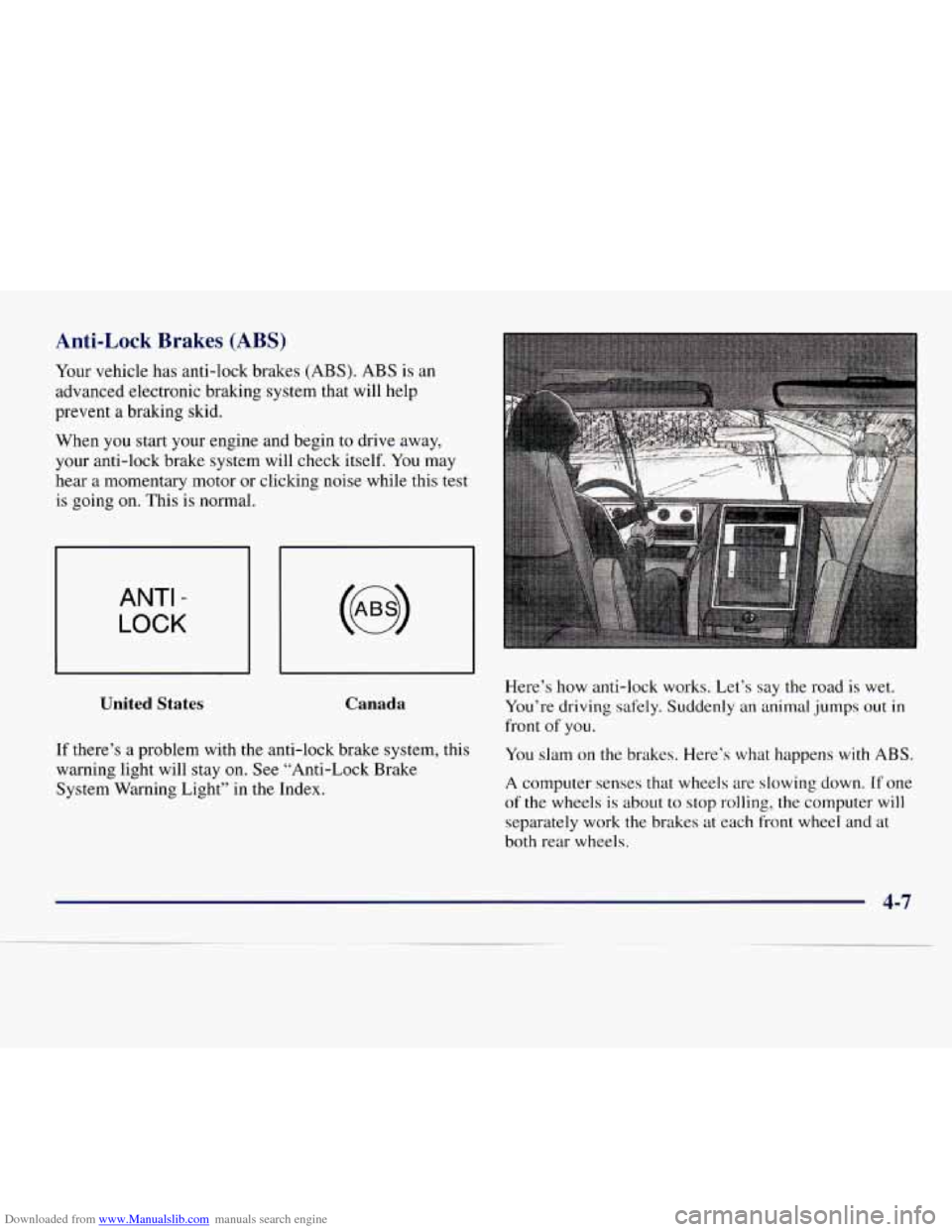
Downloaded from www.Manualslib.com manuals search engine Anti-Lock Brakes (ABS)
Your vehicle has anti-lock brakes (ABS). ABS is an
advanced electronic braking system that will help
prevent
a braking skid.
When you start your engine and begin to drive away,
your anti-lock brake system will check itself.
You may
hear a momentary motor
or clicking noise while this test
is going
on. This is normal.
ANTI -
LOCK
United States Canada
If there’s a problem with the anti-lock brake system, this
warning light will stay
on. See “Anti-Lock Brake
System Warning Light” in the Index. Here’s how anti-lock works. Let’s say the road
is wet.
You’re driving safely. Suddenly an animal jumps out
in
front of you.
You slam on the brakes. Here’s what happens with ABS.
A computer senses that wheels are slowing down. If one
of the wheels is about to stop rolling, the computer will
separately work the brakes at each front wheel and at
both rear wheels.
Page 178 of 386
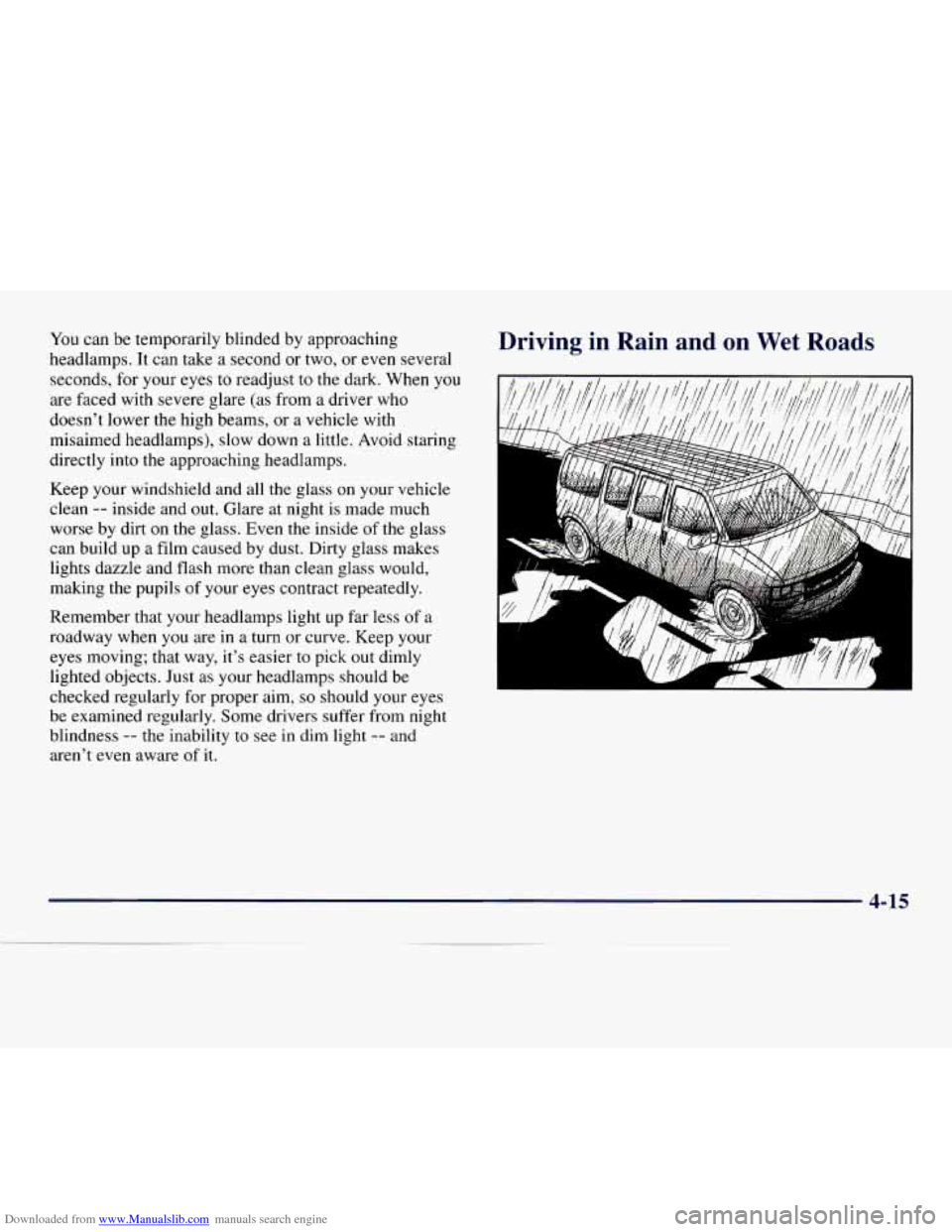
Downloaded from www.Manualslib.com manuals search engine You can be temporarily blinded by approaching
headlamps.
It can take a second or two, or even several
seconds, for your eyes to readjust to the dark. When you
are faced with severe glare (as from a driver who
doesn't lower the high beams, or a vehicle with
misaimed headlamps), slow down a little. Avoid staring
directly into the approaching headlamps.
Keep your windshield and all the glass on your vehicle
clean
-- inside and out. Glare at night is made much
worse by dirt on the glass. Even the inside of the glass
can build up a film caused by dust. Dirty glass makes
lights dazzle and flash more than clean glass would,
making the pupils of your eyes contract repeatedly.
Remember that your headlamps light up far less of a
roadway when you are in
a turn or curve. Keep your
eyes moving; that way, it's easier to pick
out dimly
lighted objects. Just as your headlamps should be
checked regularly
for proper aim, so should your eyes
be examined regularly. Some drivers suffer from night
blindness
-- the inability to see in dim light -- and
aren't even aware
of it.
Driving in E 1 Wet Roads
4-15
Page 181 of 386
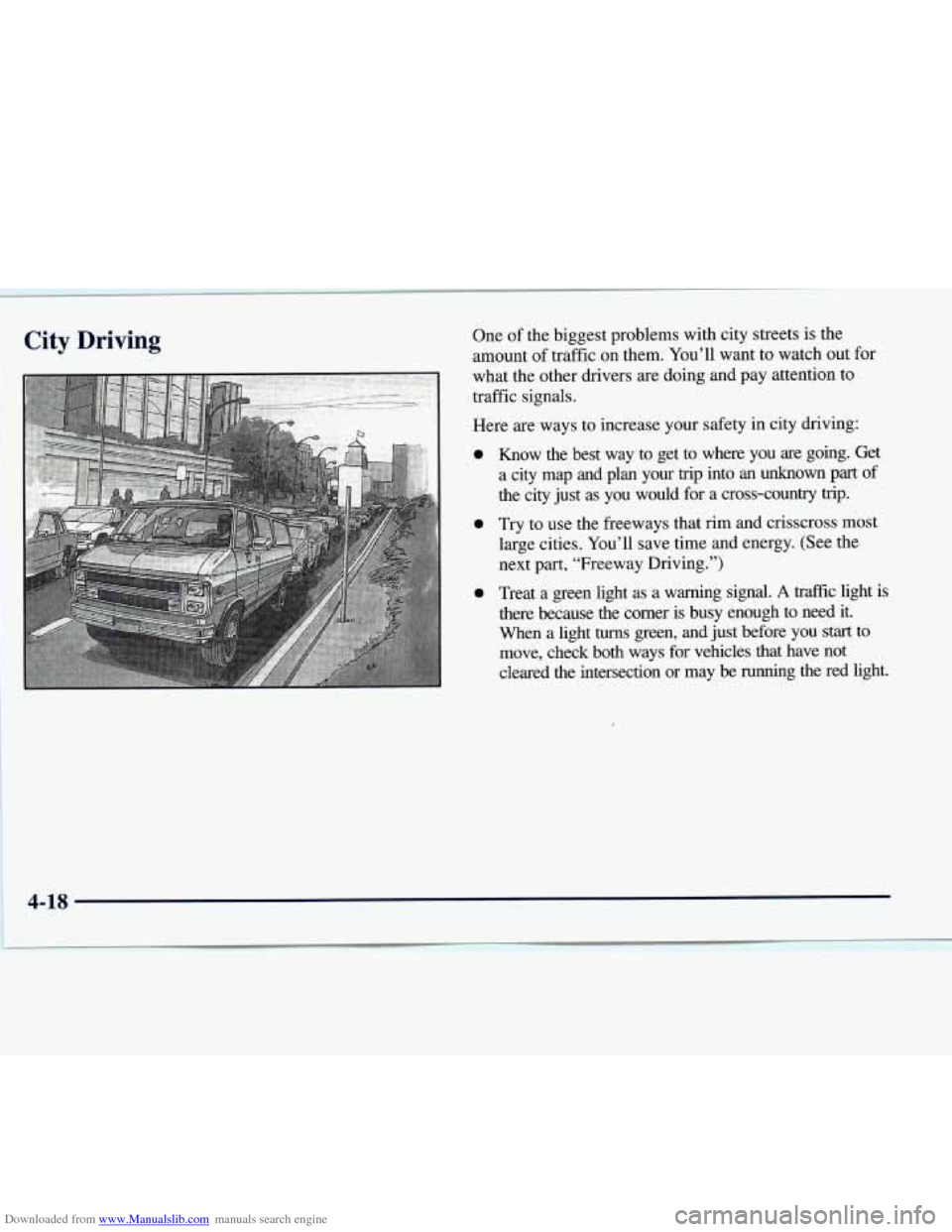
Downloaded from www.Manualslib.com manuals search engine Citv Driving One of the biggest problems with city streets is the
amount of traffic on them. You’ll want
to watch out for
what the other drivers are doing and pay attention to
traffic signals.
Here are ways to increase your safety in city driving:
0 Know the best way to get to where you are going. Get
a city map and plan your
trip into an unknown part of
the city just as you would for a cross-country hip.
0 Try to use the freeways that rim and crisscross most
large cities. You’ll save time and energy. (See the
next part, “Freeway Driving.”)
0 Treat a green light as a warning signal. A traffic light is
there because the corner is busy enough to need it. When a light
turns green, and just before you start to
move, check both ways for vehicles that have not
cleared the intersection
or may be running the red light.
4-18
Page 182 of 386
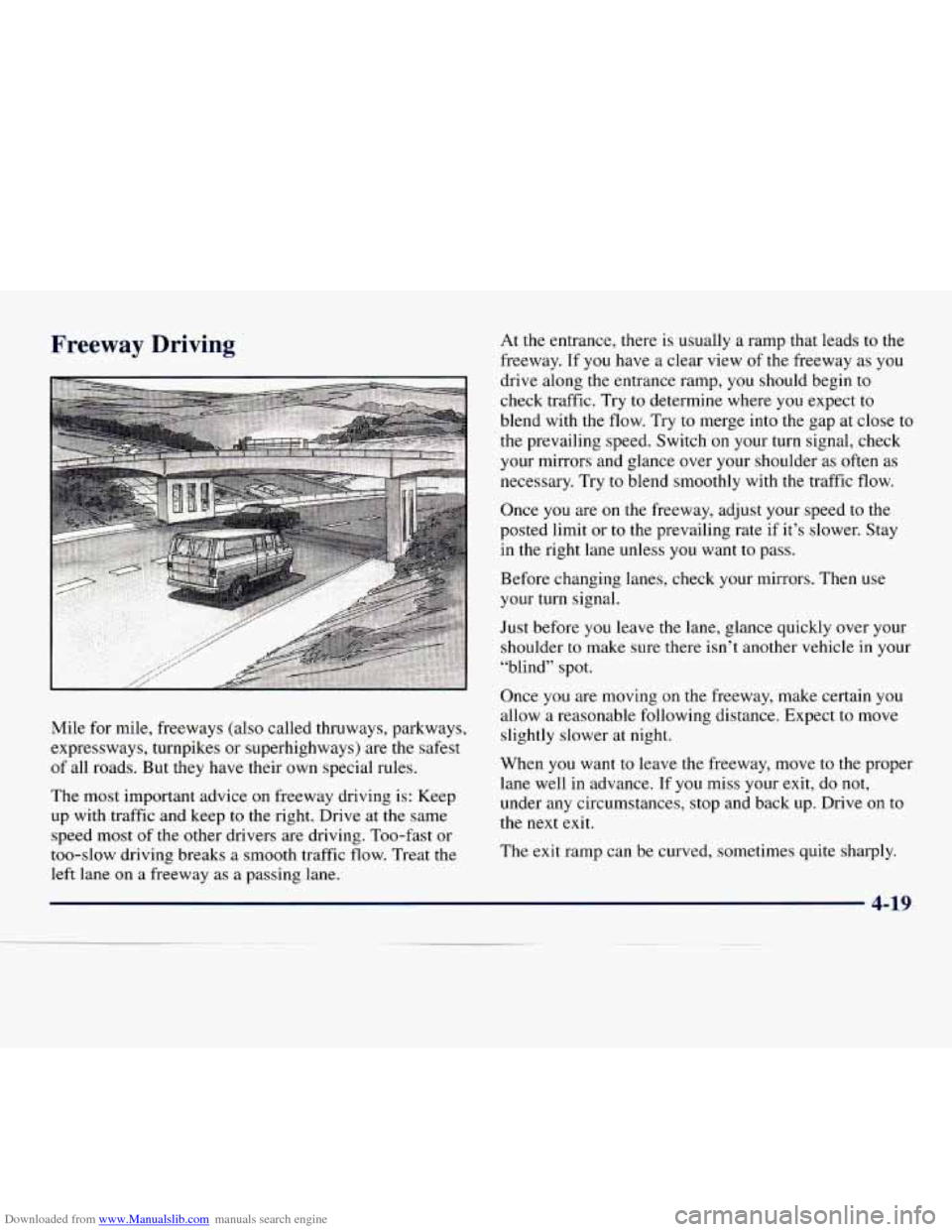
Downloaded from www.Manualslib.com manuals search engine Freeway Driving
Mile for mile, freeways (also called thruways, parkways,
expressways, turnpikes or superhighways) are the safest
of all roads. But they have their own special rules.
The most important advice on freeway driving is: Keep
up with traffic and keep to
the right. Drive at the same
speed most
of the other drivers are driving. Too-fast or
too-slow driving breaks
a smooth traffic flow. Treat the
left lane on a freeway as a passing lane. At
the entrance, there is usually a ramp that leads to the
freeway. If you have
a clear view of the freeway as you
drive along the entrance ramp,
you should begin to
check traffic. Try to determine where you expect to
blend with the flow. Try to merge into the gap at close to
the prevailing speed. Switch on your turn signal, check
your mirrors and glance over your shoulder
as often as
necessary. Try to blend smoothly with the traffic flow.
Once
you are on the freeway, adjust your speed to the
posted limit or to the prevailing rate if it’s slower. Stay
in the right lane unless you want to
pass.
Before changing lanes, check your mirrors. Then use
your turn signal.
Just before you leave the lane, glance quickly over your
shoulder to make sure there isn’t another vehicle in your
“blind” spot.
Once you are moving
on the freeway, make certain you
allow a reasonable following distance. Expect to move
slightly slower at night.
When you want
to leave the freeway, move to the proper
lane well
in advance. If you miss your exit, do not,
under any circumstances, stop and back up. Drive on to
the next exit.
The exit ramp can
be curved, sometimes quite sharply.
4-19
Page 189 of 386
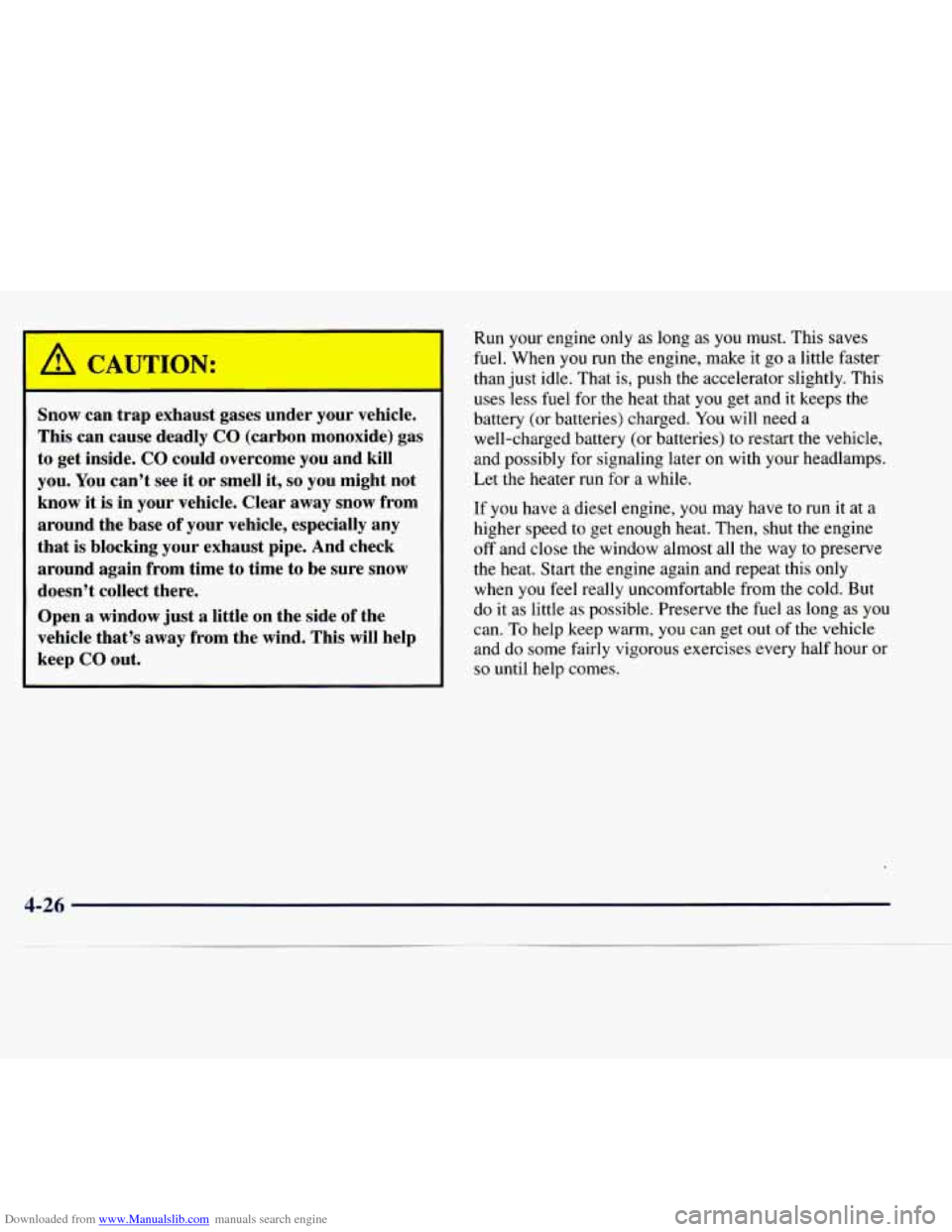
Downloaded from www.Manualslib.com manuals search engine ’ A CAUTION:
Snow can trap exhaust gases under your vehicle.
This can cause deadly
CO (carbon monoxide) gas
to get inside.
CO could overcome you and kill
you. You can’t see
it or smell it, so you might not
know it is in your vehicle. Clear away snow from
around the base of your vehicle, especially any
that is blocking your exhaust pipe. And check
around again from time to time to be sure snow
doesn’t collect there.
Open
a window just a little on the side of the
vehicle that’s away from the wind. This will help
keep
CO out.
Run your engine only as long as you must. This saves
fuel. When
you run the engine, make it go a little faster
than just idle. That is, push the accelerator slightly. This
uses less fuel for the heat that you get and it keeps the
battery (or batteries) charged. You will need a
well-charged battery (or batteries)
to restart the vehicle,
and possibly for signaling later on with your headlamps.
Let the heater run for a while.
If you have a diesel engine,
you may have to run it at a
higher speed to get enough heat. Then, shut the engine
off and close the window almost all the way to preserve
the heat. Start the engine again and repeat this only
when
you feel really uncomfortable from the cold. But
do it as little
as possible. Preserve the fuel as long as you
can. To help keep warm, you can get out of the vehicle
and
do some fairly vigorous exercises every half hour or
so until help comes.
4-26
Page 206 of 386
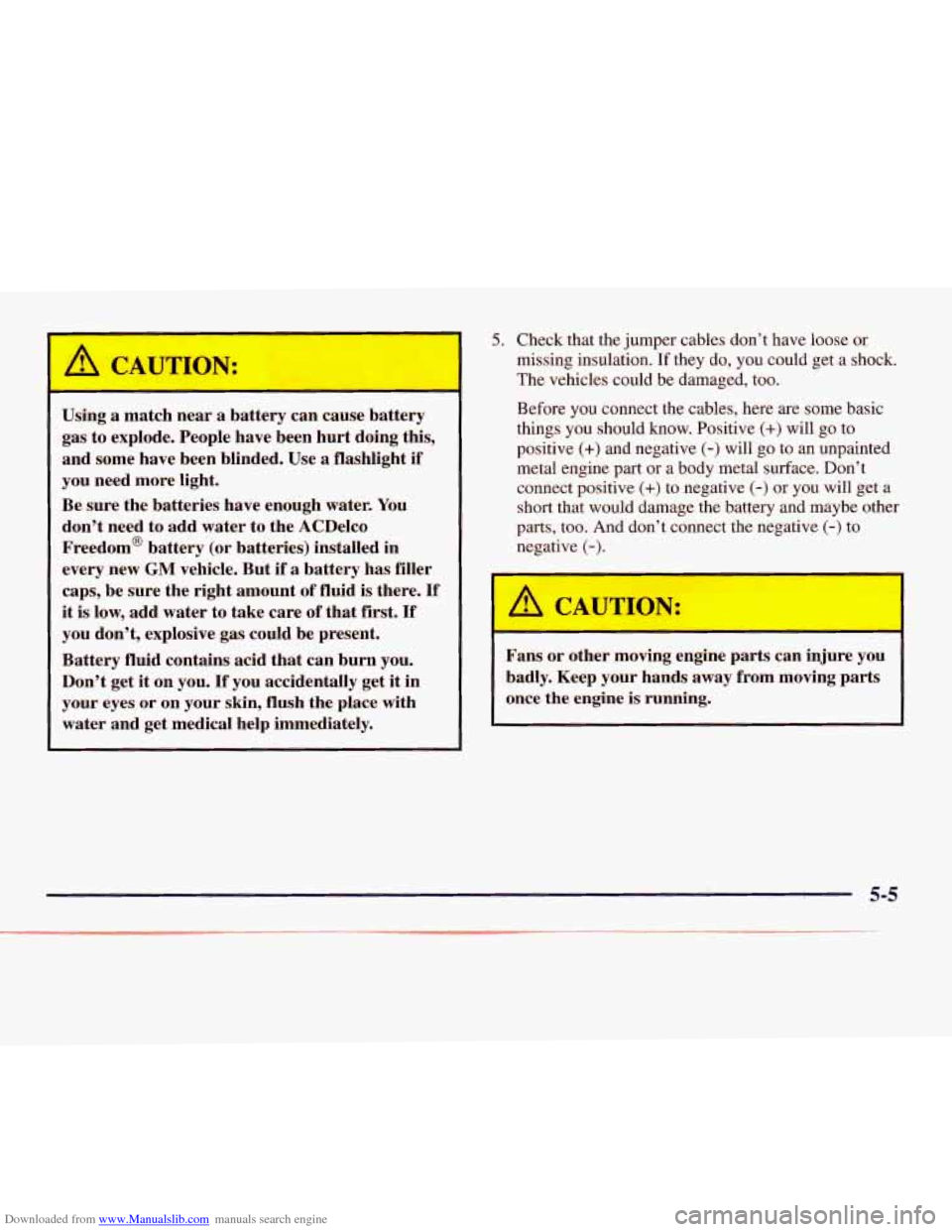
Downloaded from www.Manualslib.com manuals search engine A CAUTION:
Using a match near a battery can cause battery
gas to explode. People have been hurt doing this,
and some have been blinded. Use a flashlight
if
you need more light.
Be sure the batteries have enough water.
You
don’t need to add water to the ACDelco
Freedom@ battery (or batteries) installed in every new
GM vehicle. But if a battery has filler
caps, be sure the right amount of fluid
is there. If
it is low, add water to take care of that first. If
you don’t, explosive gas could be present.
Battery fluid contains acid that can burn you.
Don’t get it on you.
If you accidentally get it in
your eyes or on your skin, flush the place with
water and get medical help immediately.
5. Check that the jumper cables don’t have loose or
missing insulation. If they do, you could get a shock.
The vehicles could be damaged, too.
Before you connect the cables, here
are some basic
things you should
know. Positive (+) will go to
positive
(+) and negative (-) will go to an unpainted
metal engine part or a body metal surface. Don’t
connect positive
(+) to negative (-) or you will get a
short that would damage the battery and maybe other
parts, too. And don’t connect the negative
(-) to
negative
(-).
Fans or ot-- -r n-- ving engine parts can in, ..re you
badly. Keep your hands away from moving parts
once the engine
is running.
5-5
Page 260 of 386
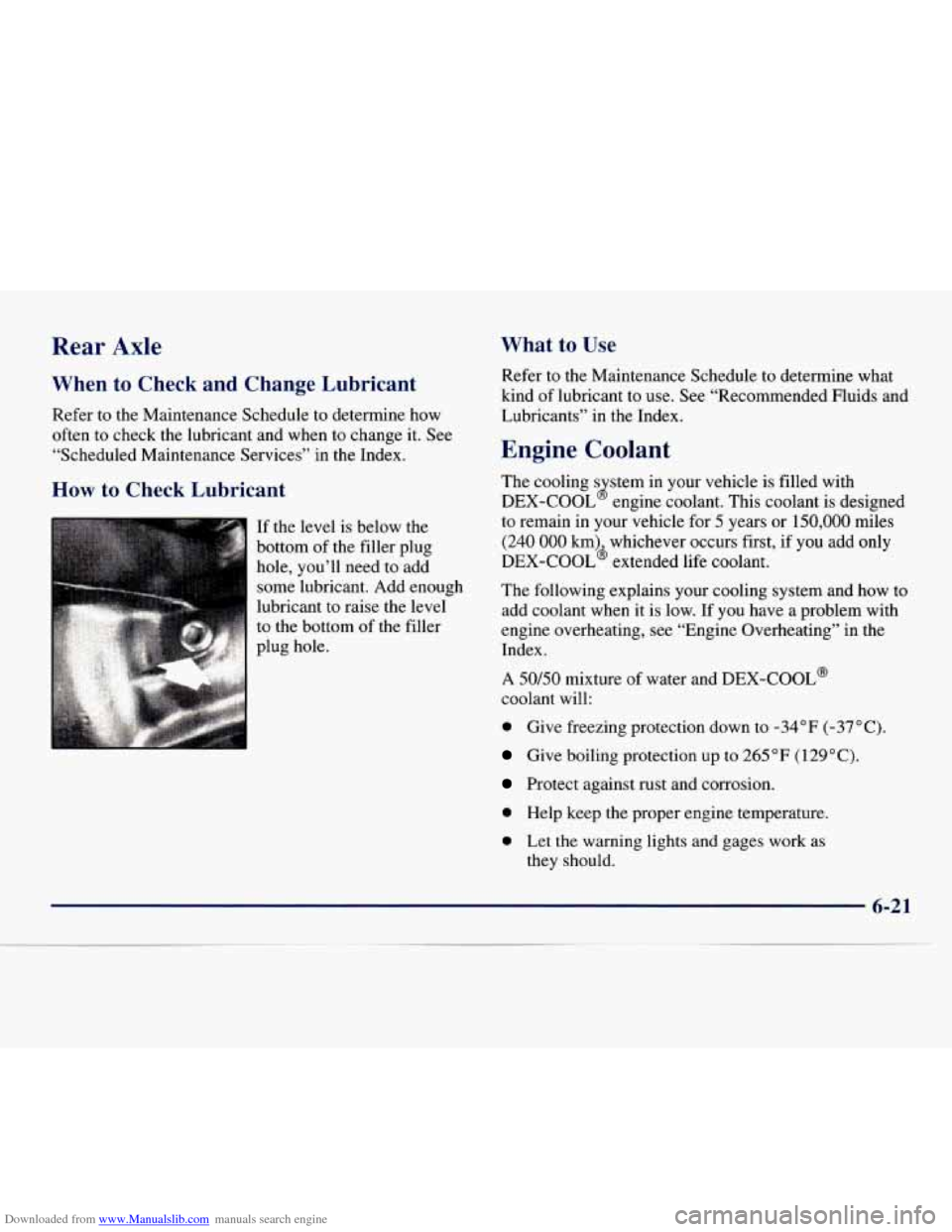
Downloaded from www.Manualslib.com manuals search engine Rear Axle What to Use
When to Check and Change Lubricant
Refer to the Maintenance Schedule to determine how
often
to check the lubricant and when to change it. See
“Scheduled Maintenance Services” in the Index.
How to Check Lubricant
If the level is below the
bottom
of the filler plug
hole, you’ll need to add
some lubricant. Add enough
lubricant to raise the level
to the bottom of the filler
plug hole. Refer
to the Maintenance Schedule to determine what
kind of lubricant to use. See “Recommended Fluids and
Lubricants” in the Index.
Engine Coolant
The cooling s stem in your vehicle is filled with
DEX-COOL engine coolant. This coolant is designed
to remain in your vehicle for
5 years or 150,000 miles
(240
000 kmg whichever occurs first, if you add only
DEX-COOL extended life coolant.
8
The following explains your cooling system and how to
add coolant when it is low. If you have a problem with
engine overheating, see “Engine Overheating” in the
Index.
A 50/50 mixture of water and DEX-COOL@
coolant will:
0 Give freezing protection down to -34°F (-37°C).
Give boiling protection up to 265 “F (1 29” C).
Protect against rust and corrosion.
0 Help keep the proper engine temperature.
0 Let the warning lights and gages work as
they should.
Page 350 of 386

Downloaded from www.Manualslib.com manuals search engine . .- . ,east Twice a Year Automatic Transmission Check
Restraint System Check
Make sure the safety belt reminder light and all your
belts, buckles, latch plates, retractors and anchorages are
working properly. Look for any other loose or damaged
safety belt system parts. If you see anything that might
keep a safety belt system from doing its
job, have it
repaired. Have any torn or frayed safety belts replaced.
Also look for any opened or broken air bag coverings,
and have them repaired or replaced. (The air bag system
does
not need regular maintenance.)
Wiper Blade Check
Inspect wiper blades for wear or cracking. Replace blade
inserts that appear worn or damaged or that streak or
miss areas of the windshield. Also see “Wiper Blades,
Cleaning” in
the Index. Check the
transmission fluid level; add if needed. See
“Automatic Transmission” in the Index. A fluid
loss may indicate a problem. Check the system and
repair if needed.
At Least Once a Year
Key Lock Cylinders Service
Lubricate the key lock cylinders with the lubricant
specified in Part
D.
Body Lubrication Service
Lubricate all hood hinges, hood prop rod pivot, fuel
filler door, rear compartment hinges, latches, locks and
any moving seat hardware. Part
D tells you what to use.
More frequent lubrication may be required when
exposed to a corrosive environment.
Page 372 of 386
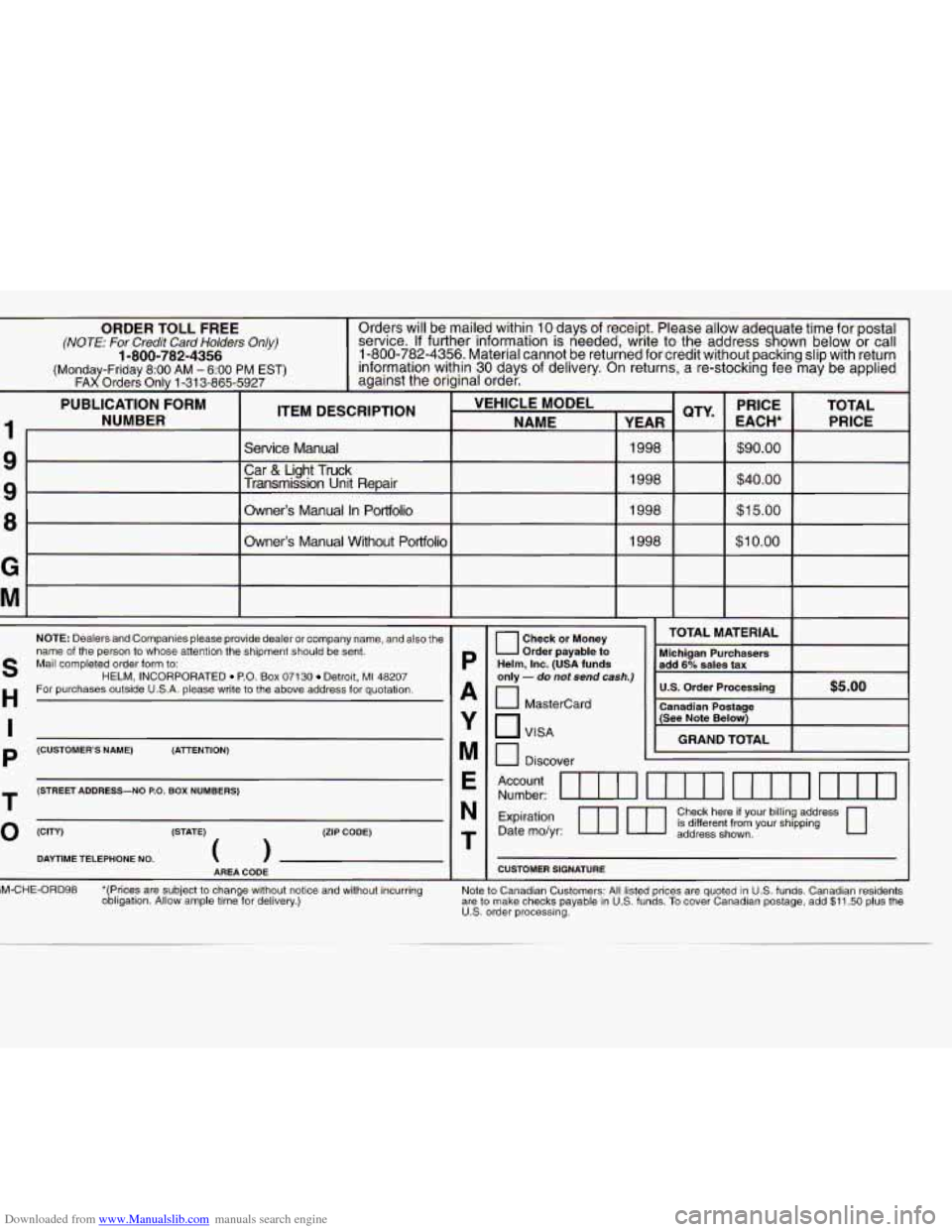
Downloaded from www.Manualslib.com manuals search engine ORDER TOLL FREE (NOTE: For Credit Card Holders Only)
Orders will be mailed within 10 days of receipt. Please allow ade uate time for postal
information within
30 days of delivery. On returns, a re-stocking fee may be applied (Monday-Friday 8:OO AM - 6:OO PM EST)
service. If further information is needed, write to the address s gh own below or call
1-800-782-4356 1-800-782-4356. Material cannot be returned for credit without p\
acking slip with return
FAX Orders Only 1-31 3-865-5927 against the original order.
PUBLICATION FORM
ITEM DESCRIPTION VEHICLE MODEL
PRICE
NAME
I YEAR
NUMBER TOTAL
EACH* QTYm PRICE
I- I
9
9
8
G
Service Manual
Car
& Light Truck $90.00
1998
Transmission Unit Repair 1998 $40.00
Owner's Manual In Portfolio
Owner's Manual Without Portfolio $1 5.00 1998
$1 0.00 1998
M
S
H
I
P
T
0
NOTE: Dealers
and Companies please provide dealer or company name, and also the
name of the person to whose attention the shipment should be sent.
Mail completed order form to:
For purchases outside USA. please write to the above address for quotation.
HELM, INCORPORATED
P.O. Box 07130 Detroit, MI 48207
(CUSTOMER'S NAME)
(ATTENTION)
(STREET ADDRESS-NO
P.O. BOX NUMBERS)
~
(CITY) (STATE) (ZIP CODE)
DAYTIME TELEPHONE
NO.
GM-CHE-ORD98 "(Prices are subject to change without notice and without incurring
obligation. Allow ample time for delivery.)
P
A
Y
M
E
N
T
-
i
Note to Canadian Customers: All listed prices are quoted in US. funds. Canadian residents
are to make checks payable in U.S. funds. To cover Canadian postage, add $11.50 plus the
U.S. order processing.
TOTAL MATERIAL
Order payable to Michigan Purchasers
Helm, Inc. (USA funds add 6% sales tax only - do not send cash.) U.S. Order Processing
Mastercard
VISA . GRAND TOTAL
u Discover I' I I
I
Account Number: uIn uIn uIn I
Expiration ml
Check here if your billing address
Date mo/yr: is different from your shipping
address shown.
CUSTOMER SIGNATURE